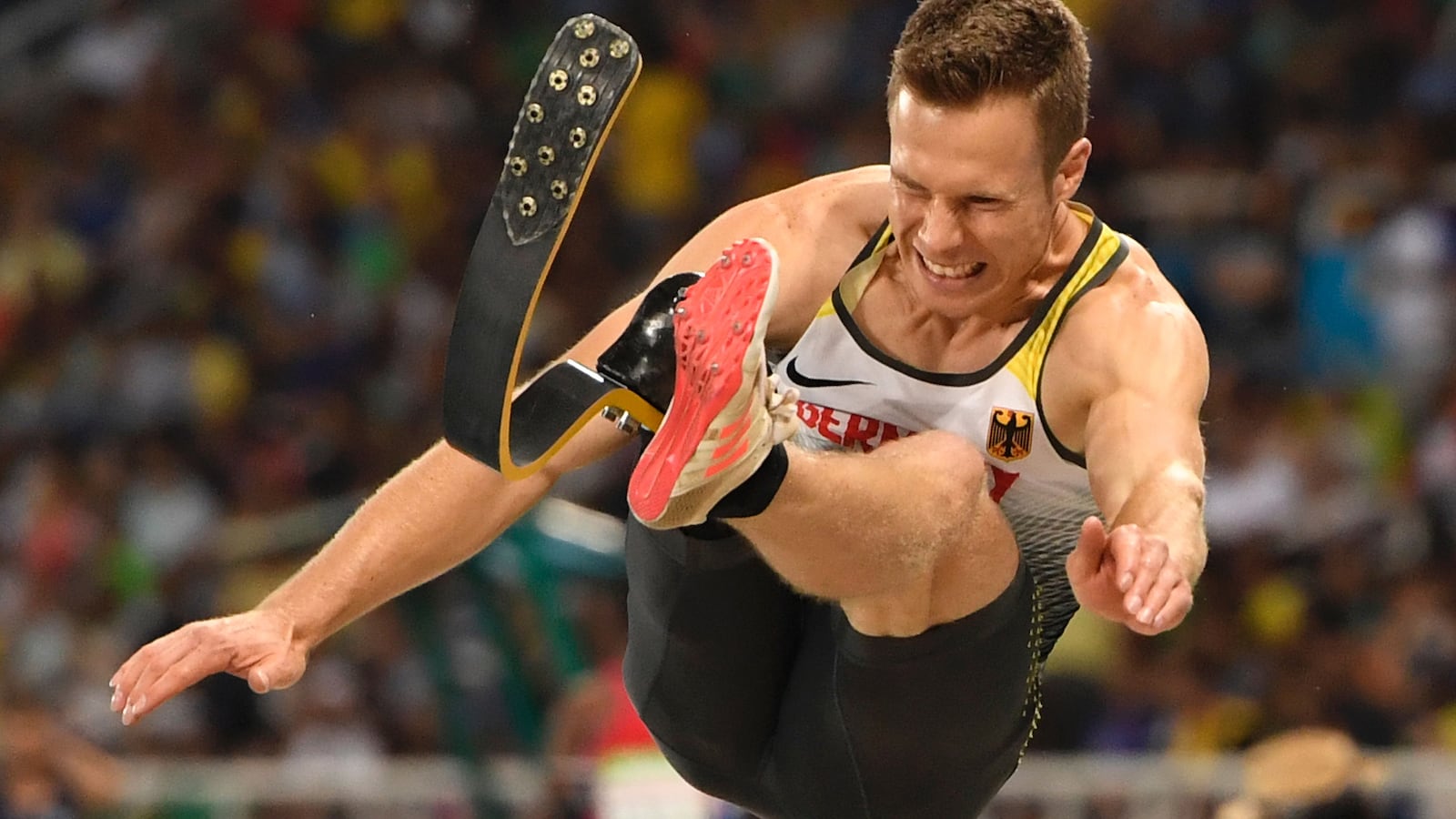With each Olympics, athletes obliterate previous records and redefine what it means to be the best. The pressure to trainer harder, master seemingly impossible moves, and run, swim, skate, or ski faster puts incredible strain on the human body, which means athletes increasingly rely on technology to boost their training regimens and to produce cutting-edge gear. No equipment has come farther faster than prostheses, which have already begun to fundamentally change the world of athletics.
The history of prosthetics in sport
The first prosthesis ever discovered is a big toe thought to belong to a female of high status in ancient Egypt nearly 3,000 years ago. Initially more ornamental than functional, prosthetic devices entered the world of recreational sports in 1888, when the Berlin Deaf Gymnastic Association was founded (the organization included chess players and bowlers, as well as gymnasts). In 1904, Olympic gymnast George Eyser won three gold, one silver, and one bronze medal while wearing a wooden leg. The 1948 London Olympics featured a wheelchair competition with 16 paralyzed athletes, organized by neurologist Ludwig Guttmann, who first thought to combine physical rehabilitation with athletics. Finally, in 1960, the “parallel Olympics,” or Paralympics, were first held in Rome.
Perhaps the most famous example of contemporary prostheses were those worn in both the Paralympics and the Olympics by South African runner Oscar Pistorius (before he shot and killed his girlfriend), known as “Blade Runner.”
But the usage of prostheses raises the question of what counts as natural talent. Will athletes who use prosthetic devices eventually be “super-abled”? Will they be the ones setting the world records? And if so, how might that impact sports?
Bringing prosthetics to the Olympics
Pistorius’s customized carbon-fiber prosthetic blades (which cost more than $15,000) helped propel him to victory at the 2004, 2008, and 2012 Paralympics. In 2012, he became the first amputee sprinter in the Olympics. But it took years of struggle and controversy to get there.
Pistorius’s road to the Olympics paved the way for the consideration of prosthetics in the quadrennial event, and began in 2007, when the IAAF changed its rules to ban athletes from using any device that “provides a user with an advantage over another athlete not using such a device." Initially, the IAAF had to prove the advantageous nature of a device. IAAF-affiliated biomechanics professor Peter Bruggeman performed tests on Pistorius and determined that his blades allowed him to expend approximately 25 percent less energy than other runners. The IAAF ruled Pistorius ineligible for the 2008 Olympics.
Pistorius appealed the decision to the Court for Arbitration of Sport and countered Bruggeman’s findings with a Rice University study that concluded the blades were “physiologically similar but mechanically different from running with biological legs,” and that Pistorius' energy expenditure was similar to that of other elite athletes. The Court found no conclusive evidence that Pistorius’ legs gave him an advantage and allowed him to compete in the 2012 Olympics, where he ran a season-best 400 meters, but ultimately didn’t medal.
A similar case involved long-jumper Marcus Rehm, a 2012 Paralympic gold medalist. In 2014, Rehm qualified for the European Championships after winning the German Athletics championship, but the German Track and Field Federation ruled that Rehm’s blade prosthetic gave him an unfair advantage when sprinting and when taking off from his prosthetic leg. Meanwhile, the IAAF again amended its rules, requiring athletes to prove their prostheses don’t give them a competitive advantage. Even though a study found no definitive benefit for Rehm, the IAAF ruled him ineligible to compete in the 2016 London games.
When the Court decided Pistorius’ appeal, it made a distinction between active prostheses (devices with motors, wheels, etc) and passive prostheses. The former, it argued, are clearly unfair, but not the latter: “If the use of the device provides more disadvantages than advantages, then it cannot reasonably be said to provide an advantage over other athletes.” But such assessments aren’t easy, even for scientists.
What makes a talent "natural"?
The seven researchers who tested Pistorius at Rice in 2008 didn’t reach a consensus about the results of their tests. A physiologist from the group believed that Pistorius did have an advantage because the blades allow for different types of movement than legs and feet. But the group’s biomechanics professor argued that any advantage was obviated by the blades’ disadvantages. Scientists are relatively new at studying the complicated mechanics of running, which explains some of these discrepancies.
The ambiguity of the rules is also problematic. What constitutes an “advantage” over another athlete? Can it be absolutely measured, and if so, how?
Such scenarios are bound to become both trickier and more numerous, especially now that certain types of shoes potentially offer advantages to athletes as well. What should the rules defining and permitting prostheses be? Should the IAAF—already busy handling doping, fraud, and other controversies—shift the task of determining eligibility of prostheses to the International Paralympic Committee (IPC)? What is the best way to ensure competitive fairness?
In an email interview with The Daily Beast, sports historian and Arizona State University History Professor Victoria Jackson suggested that a “body independent of the IAAF and the athletes should research the question of prosthetic devices' presence or lack of an advantage” because researchers need “true autonomy” if the results are to be meaningful and fair. Jackson also emphasized that the type of advantage matters. Blades such as Pistorius and Rehm’s are, in Jackson’s opinion, not performance-enhancing. Instead, they “improve recovery time, which allows the athlete to train harder, which therefore enhances performance.” If a prosthetic device allows an athlete to rest less and train more, does it offer a competitive advantage? What about embedded micro-chips that can gather and analyze data, or biofeedback devices like stress-sensors that can help guide training?
Some assistive technologies are easier to assess, such as exoskeletons that allow wearers to bicep curl 175 pounds or mind-controlled prostheses. Athletes using those devices now have a competition venue: CYBATHLON, which first took place in Zurich in 2016 and is scheduled again for 2020. CYBATHLON holds events in six disciplines for both muscle-powered and mind-controlled devices, including exoskeletons races and contests conducted via brain-computer interfaces. Awards go to the athletes or “pilots” and to the laboratory that made their device.
According to Roland Sigrist and Dario Wyss, co-directors of CYBATHLON, the event is different in two major ways from the Paralympics: CYBATHLON doesn’t have to wade into murky rule territory because “only high-tech devices are eligible.” Second, CYBATHLON “is not about sports, but about daily life tasks. Thus, the goal of CYBATHLON is to push the development of assistive technology not only for athletes, but for many people that can profit from these developments.” Because of this, the atmosphere at CYBATHLON 2016 was universally supportive, and Sigrist says the audience demonstrated “empathy that nobody could ever expect,” rather than limiting their cheering to their favorite athletes.
Claudia Briedbach, who was born without a left arm, finished fourth in the powered arm event using the Touch Bionics i-limb quantum, which isn’t specifically designed for sports, but allows her to control grips and gestures to the extent that she can eat sushi with chopsticks. Briedbach, an avid skydiver, first competed with a prostheses at the 2012 German Nationals for Skydiving. When I asked her about the IAAF rule, she said, “no prosthesis can be better than a human extremity” and such devices require incredible athleticism and skill to control. She pointed out that Rehm used to jump before he lost his leg in an accident, and afterward, his options weren’t great—he could stop competing or “justify himself in front of people without disabilities.” When asked if her prosthetic gives her an advantage, she simply said, “I feel like a real athlete.”
Sports psychologist Jason Mazanov raises an ethical question about “authenticity.” Is an athlete’s performance “a result of … the athlete or … the technology?” While this is the question the IAAF wants to untangle, it presupposes a binary—that a performance is due either to an athlete or to technology. That viewpoint perpetuates at best a lack of understanding of athletes with prostheses and at worst a form of ableism. Oscar Pistorius was a sprinter, regardless of whether he ran on feet or blades. The same goes for Briedbach, who uses her prosthetic for everything from competing to chopping vegetables to typing. She wouldn’t look at her prosthetic and think, “that’s my i-limb quantum.” She’d think, “that’s my hand.”
Briedbach hopes that eventually, the Olympics and other international competitions will “bring disabled and non-disabled people together.” She hopes athletes like her will have more opportunities to participate in traditional competitions because “there is no better way to show what is possible than in sports.”





